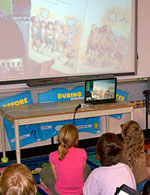At a Glance
What is it?
Website
Skype

What is it?
Skype is a Voice-Over-Internet Protocol (VOIP) program that allows users on different computers in different locations to videoconference via an internet connection. The free software enables both audio and audiovisual options. Use it to communicate classroom-to-classroom around the globe or across the hall. Skype enables synchronous teacher-to-teacher and class-to-class communication, and enables you to bring outside experts into the class without leaving the room.
Getting Started
Skyping is an uncomplicated process. A computer with a high-speed internet connection, a microphone, and a webcam (built-in or external) constitute the hardware required to begin. First, you'll download the software appropriate for your computer—for PC or Mac, and create a username and password . Then all you need to do is develop your contact list and test your equipment with a trial call.
Of course, in order to have a conversation via Skype, both parties need to be signed in. You'll find your contact list in the left side of your Skype window. When the telephone icon next to a name is green, your party is logged on and ready for a conversation or an IM. To add a contact, click the plus sign in the lower left-hand corner or use the Contacts selection in the Skype navigation bar.
Basic Skype really IS easy to use—as easy as making a phone call. What, then, can go wrong? Occasionally connections are lost or the sound goes awry. It's best to be prepared with a contingency plan about who will redial if that happens, and also to have a simultaneous IM connection to keep in touch. Testing your equipment in advance will ensure that sound and video settings are correct. You'll select and confirm your audio and camera settings under the preferences option in the drop down menu under Skype in the nav bar.
For Skype events involving a group, you'll want to add projection equipment to your setup so that everyone can see and participate. It's also possible to record Skype conversations and videoconferences for later reference and projects, including creating podcasts.
Examples
Skype helps you bridge geographic divides, work collaboratively with groups outside your classroom, and conduct question-and-answer sessions with consultants. It's a useful videoconferencing tool for professional development, and the program can help homebound students keep in touch.
Skype and other videoconferencing tools support inquiry-based learning, and like most technology tools, Skype can both augment the substance of curriculum content and serve as curriculum content area itself to teach a variety of skills. Skype (and other interviewing and collaborative experiences) occur in a proscribed timeframe, and you'll want to focus on planning skills to maximize how your class uses that allotted time. Pre-planning helps keep the conversation focused and on-topic. Discussion, and post-interview analysis of a video-conference foster both critical thinking skills about the subject and about proficient use of the technology. A well-planned Skype session encourages students to probe the problem they're working on to frame and ask thoughtful questions.
Ask students to formulate questions in advance, based upon the project or subject and to develop backup or secondary topics of inquiry. To interview a consultant or expert, students might research their interviewees biography and find any ideas that person might already have expressed about the subject of the discussion. After the videoconference, debriefings pinpoint the most valuable information and approaches and offer a chance to frame what's next.
Neil Stephenson, a middle school teacher in Canada, addresses The Many Roles of Skype in the Classroom, describing an ongoing Skype conversation with a curator at Canada's National Museum over the course of the school year as students worked on specific history projects. How did it encourage learning? Students had the opportunity to see the value of their work in the context of the work of a historian, to get feedback, and to hear firsthand about what curatorial work is and does. Stephenson talks about his first steps with Skype in the classroom and highlights examples in his blog.
The Eisenhower Middle School in Wickoff, New Jersey, recorded Skype interviews with students on field trips to historic sites and interviews.
A first grade class in Virginia talked to a penpal in London with whom they'd corresponded all year. The teacher-librarian who developed the project thought "what shocked them the most was the concept that the person they were talking to had just eaten dinner when they had just eaten lunch!"
Skype can be an excellent medium for collecting oral histories. The Educause Learning Intitiative suggests seven things you should know about Skype, citing and examples from an Arizona tribal college that would work equally well in K-12 classrooms. Students collected oral histories and recordings that were later turned into podcasts and other digital and web-based projects.
For more information
Using Skype in the Classroom from Robert Murcha, a sixth grade teacher, is a concise step-by-step-by-step guide to Skyping, including caveats about classroom management, chatting while skyping, and diction.
Skype in Schools created by Dan Froelich is an active wiki with some helpful insights on how to use Skype, on successful projects, and information about schools and classrooms looking for Skype partners.
Yes, it's another "Best of" list, however 50 Awesome Ways to Use Skype in the Classroom is a diverse set of quick links to technical, pedogogical, and collaborative possibilities using Skype.
Education Week considers the future of videoconferencing in classrooms—including the development of Skype in Education, an upcoming website created by Skype Technologies to bring together Skype-using educators.